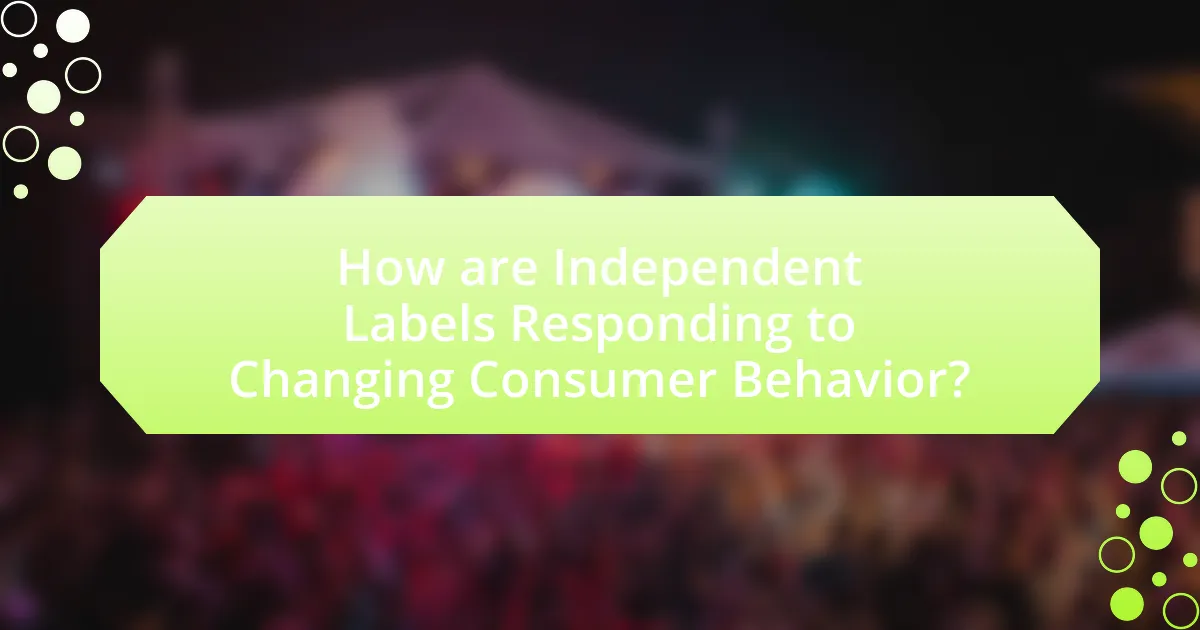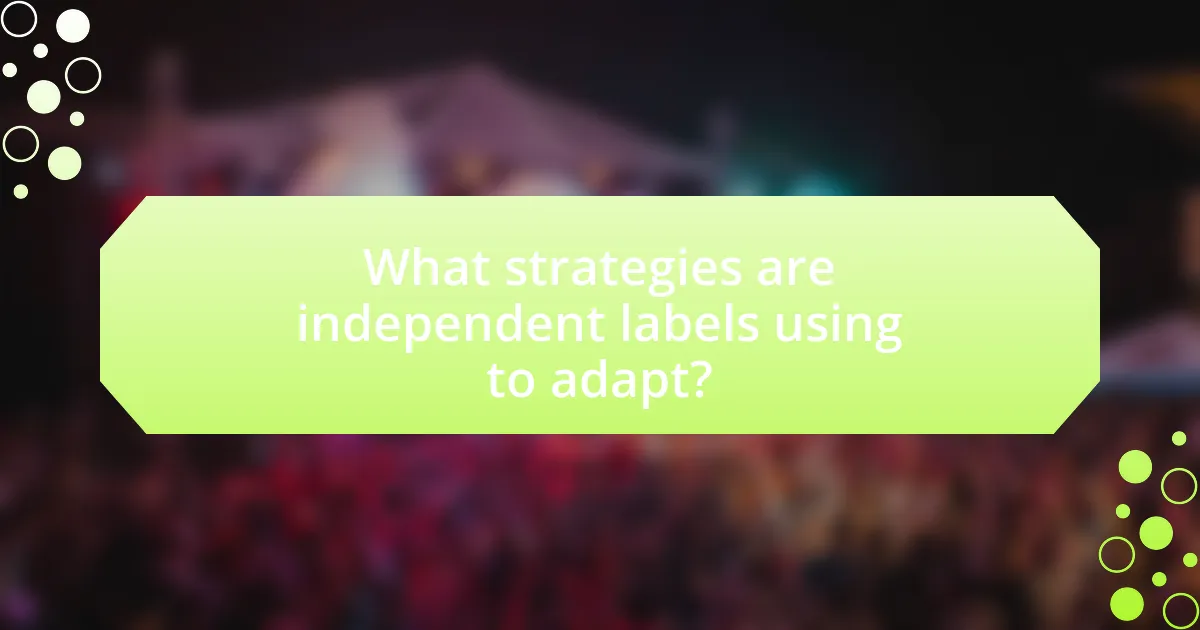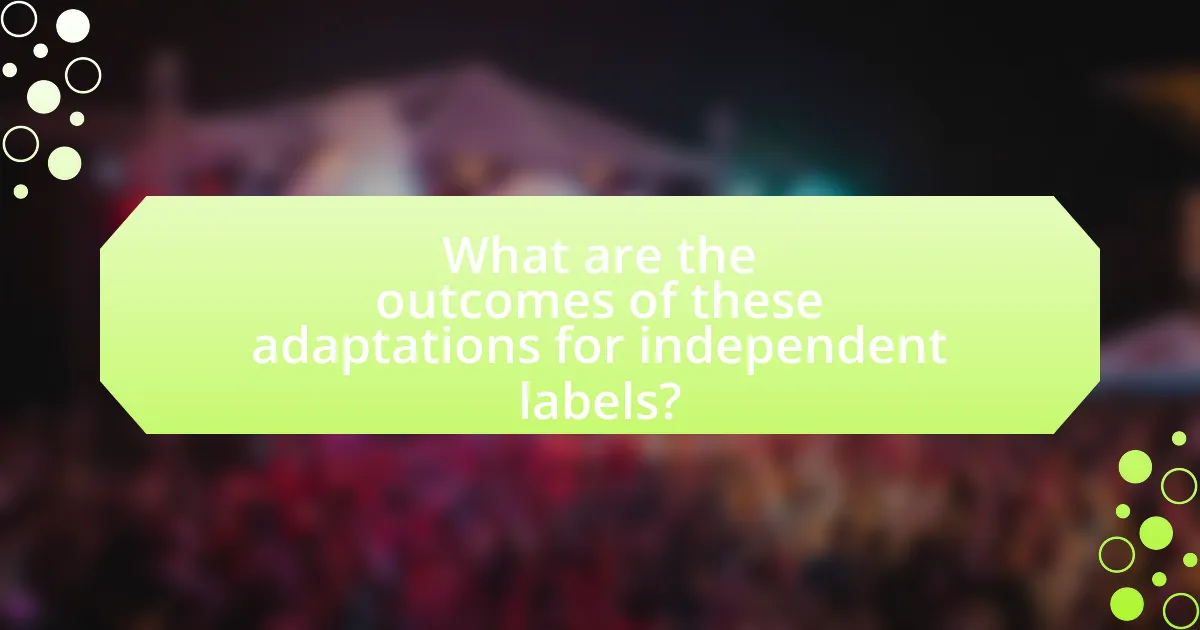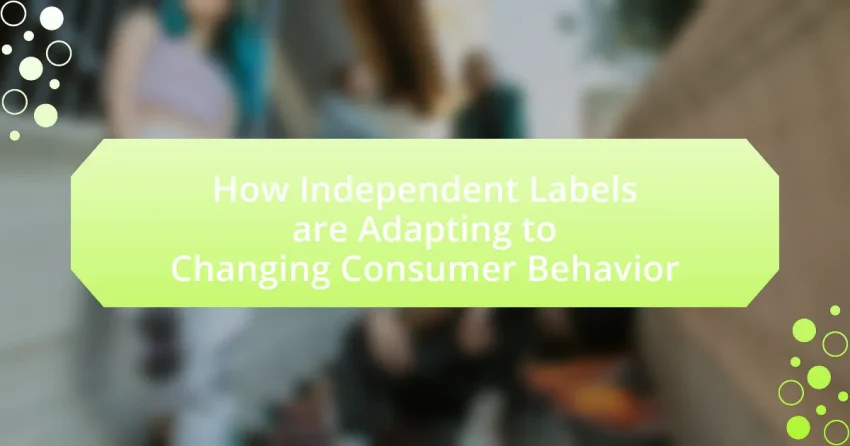Independent labels are increasingly adapting to changing consumer behavior by focusing on digital platforms and direct-to-consumer sales, driven by the rise of streaming services and social media. This article explores the factors influencing consumer behavior in the music industry, including technological advancements and social media’s role in shaping preferences. It examines how independent labels leverage data analytics and innovative marketing strategies to enhance engagement and revenue, while also addressing the challenges they face in a competitive market. The discussion highlights the importance of adaptation for sustainability and outlines emerging revenue streams and best practices that can guide independent labels in the evolving landscape.

How are Independent Labels Responding to Changing Consumer Behavior?
Independent labels are responding to changing consumer behavior by increasing their focus on digital platforms and direct-to-consumer sales. This shift is driven by the rise of streaming services and social media, which have transformed how music is consumed and marketed. For instance, independent labels are leveraging platforms like Bandcamp and SoundCloud to reach audiences directly, bypassing traditional distribution channels. Additionally, they are utilizing data analytics to understand consumer preferences and tailor their marketing strategies accordingly. This adaptation is evident in the growing trend of independent artists using social media for promotion, which has been shown to enhance fan engagement and drive sales.
What factors are influencing consumer behavior in the music industry?
Factors influencing consumer behavior in the music industry include technological advancements, social media influence, and changing consumption patterns. Technological advancements, such as streaming services, have shifted how consumers access and enjoy music, leading to a preference for on-demand listening. Social media platforms play a crucial role in shaping consumer preferences by facilitating artist discovery and engagement, as evidenced by the rise of viral trends on platforms like TikTok. Additionally, changing consumption patterns, including a growing inclination towards digital purchases over physical formats, reflect a broader trend towards convenience and instant access in consumer behavior.
How has digital streaming changed consumer preferences?
Digital streaming has significantly shifted consumer preferences towards on-demand access and personalized content. Consumers now favor platforms that allow them to choose what, when, and how they consume media, leading to a decline in traditional media formats such as CDs and DVDs. According to a 2021 report by the Recording Industry Association of America, streaming accounted for 83% of the music industry’s revenue, illustrating a clear preference for digital formats over physical sales. This transition has also encouraged independent labels to adapt their marketing strategies, focusing on digital platforms to reach audiences effectively.
What role do social media platforms play in shaping consumer choices?
Social media platforms significantly influence consumer choices by facilitating access to information, peer reviews, and targeted advertising. These platforms enable users to discover products through recommendations from friends, influencers, and brands, which can lead to increased trust and likelihood of purchase. For instance, a study by Nielsen found that 92% of consumers trust recommendations from friends and family over any other form of advertising. Additionally, social media algorithms curate content that aligns with users’ interests, further shaping their preferences and purchasing decisions. This targeted approach not only enhances user engagement but also drives sales for brands, particularly independent labels that leverage these platforms to reach niche markets effectively.
Why is it important for independent labels to adapt?
It is important for independent labels to adapt because changing consumer behavior directly impacts their market viability and revenue streams. As digital consumption increases, independent labels must embrace new distribution methods and marketing strategies to reach audiences effectively. For instance, a report by the International Federation of the Phonographic Industry (IFPI) indicates that streaming now accounts for over 60% of global recorded music revenue, highlighting the necessity for independent labels to pivot towards digital platforms to remain competitive. Adapting to these trends allows independent labels to not only survive but also thrive in a rapidly evolving music industry landscape.
What challenges do independent labels face in a changing market?
Independent labels face significant challenges in a changing market, primarily due to competition from major labels and the rise of digital streaming platforms. These independent labels struggle to secure funding and resources, which limits their marketing capabilities and artist development compared to their larger counterparts. Additionally, the shift in consumer behavior towards streaming services has altered revenue models, making it difficult for independent labels to generate sustainable income. According to a report by the International Federation of the Phonographic Industry, independent labels accounted for only 30% of global recorded music revenues in 2022, highlighting their financial constraints in a market dominated by major labels.
How can adaptation lead to sustainability for independent labels?
Adaptation can lead to sustainability for independent labels by enabling them to respond effectively to changing consumer preferences and market dynamics. By embracing digital platforms, independent labels can reach wider audiences and reduce distribution costs, which enhances their financial viability. For instance, a report by the International Federation of the Phonographic Industry (IFPI) indicates that digital music revenues grew by 19.9% in 2020, highlighting the importance of adapting to digital consumption trends. Furthermore, independent labels that prioritize sustainable practices, such as eco-friendly packaging and ethical sourcing, can attract environmentally conscious consumers, thereby increasing their market share. This strategic adaptation not only ensures survival but also fosters long-term sustainability in a competitive industry.

What strategies are independent labels using to adapt?
Independent labels are using digital marketing, direct-to-consumer sales, and strategic partnerships to adapt to changing consumer behavior. Digital marketing allows these labels to reach niche audiences through targeted social media campaigns and online platforms, enhancing visibility and engagement. Direct-to-consumer sales enable independent labels to bypass traditional distribution channels, increasing profit margins and fostering closer relationships with fans. Additionally, strategic partnerships with brands and other artists help expand their reach and resources, as evidenced by collaborations that have successfully increased audience engagement and revenue streams.
How are independent labels leveraging technology to reach consumers?
Independent labels are leveraging technology by utilizing digital platforms for distribution, marketing, and audience engagement. These labels often employ social media channels, streaming services, and direct-to-consumer sales platforms to reach a wider audience. For instance, independent labels can distribute music through platforms like Bandcamp and SoundCloud, which allow artists to connect directly with fans and retain a larger share of revenue compared to traditional distribution methods. Additionally, data analytics tools enable these labels to understand consumer preferences and tailor their marketing strategies accordingly, enhancing their ability to engage with specific demographics effectively. This approach has been validated by the rise of independent artists achieving significant success through online platforms, demonstrating the effectiveness of technology in reaching consumers.
What tools are being used for marketing and distribution?
Independent labels are utilizing digital marketing tools and social media platforms for marketing and distribution. These tools include email marketing services like Mailchimp, social media advertising on platforms such as Facebook and Instagram, and music distribution services like DistroKid and TuneCore. According to a 2022 report by MIDiA Research, 70% of independent labels leverage social media for audience engagement, highlighting its effectiveness in reaching consumers directly. Additionally, the use of analytics tools such as Google Analytics helps labels track consumer behavior and optimize their marketing strategies.
How do data analytics inform decision-making for independent labels?
Data analytics inform decision-making for independent labels by providing insights into consumer preferences, market trends, and performance metrics. Independent labels utilize data analytics to analyze streaming statistics, social media engagement, and sales data, allowing them to identify which artists or genres are gaining traction. For instance, a report from MIDiA Research indicates that independent labels that leverage data analytics can increase their market share by up to 30% by making informed decisions on marketing strategies and artist development. This data-driven approach enables independent labels to allocate resources more effectively, tailor their promotional efforts, and ultimately enhance their competitive edge in a rapidly evolving music industry.
What innovative approaches are independent labels taking in artist promotion?
Independent labels are utilizing data-driven marketing strategies and social media engagement to promote artists innovatively. By leveraging analytics tools, these labels can identify target audiences and tailor promotional campaigns effectively. For instance, platforms like Spotify and Instagram provide insights into listener demographics and engagement patterns, allowing independent labels to create personalized content that resonates with specific fan bases. Additionally, independent labels are increasingly collaborating with influencers and utilizing user-generated content to enhance visibility and authenticity, which has been shown to significantly boost artist reach and fan interaction.
How are collaborations with influencers impacting label visibility?
Collaborations with influencers significantly enhance label visibility by leveraging the influencers’ established audiences to reach new potential fans. This strategy allows independent labels to tap into niche markets and demographics that may not be accessible through traditional marketing channels. For instance, a study by Influencer Marketing Hub found that 63% of marketers believe influencer collaborations help increase brand awareness, demonstrating the effectiveness of this approach. Additionally, influencers often create authentic content that resonates with their followers, further amplifying the label’s presence in the market.
What role does live streaming play in promoting artists?
Live streaming plays a crucial role in promoting artists by providing them with a direct platform to engage with their audience in real-time. This interactive medium allows artists to showcase their music, connect personally with fans, and build a loyal following. According to a report by Nielsen, 63% of fans prefer live streaming events as a way to experience music, highlighting its effectiveness in reaching wider audiences. Additionally, platforms like Twitch and YouTube Live have enabled artists to monetize their performances through donations and subscriptions, further enhancing their visibility and financial sustainability.

What are the outcomes of these adaptations for independent labels?
The outcomes of adaptations for independent labels include increased market reach, enhanced consumer engagement, and improved financial sustainability. By embracing digital platforms and social media, independent labels can connect directly with audiences, leading to a broader fan base. For instance, a report by MIDiA Research indicates that independent labels have seen a 30% increase in streaming revenue due to effective online marketing strategies. Additionally, these adaptations allow for more personalized interactions with consumers, fostering loyalty and repeat business. As a result, independent labels are not only surviving but thriving in a competitive landscape.
How have sales and revenue models changed for independent labels?
Sales and revenue models for independent labels have shifted from traditional physical sales to digital streaming and direct-to-consumer sales. This change is driven by the rise of platforms like Spotify and Apple Music, which have transformed how music is consumed, leading to a significant decline in physical album sales. According to the Recording Industry Association of America (RIAA), streaming accounted for 83% of the U.S. music industry’s revenue in 2021, highlighting the dominance of this model. Additionally, independent labels are increasingly leveraging social media and crowdfunding platforms to engage directly with fans, allowing them to generate revenue through merchandise sales and exclusive content offerings. This evolution reflects a broader trend where independent labels adapt to the digital landscape, focusing on building direct relationships with their audience to sustain and grow their revenue streams.
What new revenue streams are emerging for independent labels?
New revenue streams emerging for independent labels include direct-to-consumer sales, subscription services, and digital licensing. Independent labels are increasingly leveraging platforms like Bandcamp and Patreon to sell music and merchandise directly to fans, which allows for higher profit margins compared to traditional distribution methods. Additionally, subscription services such as Spotify and Apple Music provide independent labels with royalties based on streaming, while digital licensing opportunities for sync placements in film, television, and advertising create new income avenues. According to a 2022 report by the International Federation of the Phonographic Industry, independent labels accounted for 32% of global recorded music revenue, highlighting their growing financial significance in the industry.
How do consumer engagement metrics reflect the success of these adaptations?
Consumer engagement metrics indicate the success of adaptations by measuring how effectively independent labels connect with their audience. High levels of engagement, such as increased social media interactions, streaming numbers, and email open rates, demonstrate that these labels are resonating with consumers and successfully meeting their evolving preferences. For instance, a 2022 report from the International Federation of the Phonographic Industry (IFPI) highlighted that independent labels saw a 30% increase in streaming engagement after implementing targeted marketing strategies, showcasing their ability to adapt to consumer behavior changes.
What lessons can be learned from the adaptation strategies of independent labels?
Independent labels demonstrate that agility and innovation are crucial for survival in a rapidly changing music industry. These labels often leverage digital platforms for direct artist-to-fan engagement, which allows them to build loyal communities and generate revenue without relying on traditional distribution methods. For instance, Bandcamp has enabled many independent artists to sell their music directly to consumers, resulting in higher profit margins compared to conventional sales channels. Additionally, independent labels frequently adopt diverse revenue streams, such as merchandise sales and live performances, to mitigate risks associated with fluctuating music sales. This multifaceted approach not only enhances financial stability but also fosters deeper connections with audiences, illustrating the importance of adaptability in a competitive landscape.
What best practices can other labels adopt from successful independent labels?
Successful independent labels prioritize direct artist engagement, which fosters a loyal fanbase and enhances marketing effectiveness. By utilizing social media platforms for authentic communication, independent labels can create a personal connection with audiences, as evidenced by the success of labels like Sub Pop, which effectively used platforms like Twitter and Instagram to promote artists and build community. Additionally, independent labels often embrace innovative distribution methods, such as Bandcamp, which allows artists to sell directly to fans, maximizing revenue and control over their music. This approach has been validated by the increasing number of artists choosing to release music independently, reflecting a shift in consumer behavior towards supporting direct artist-to-fan transactions.
How can independent labels continue to evolve in the future?
Independent labels can continue to evolve in the future by leveraging digital platforms and data analytics to better understand consumer preferences. By utilizing streaming services and social media, these labels can gather insights on listener behavior, allowing them to tailor marketing strategies and music releases to meet audience demands. For instance, the rise of platforms like Bandcamp and SoundCloud has enabled independent artists to reach niche markets directly, bypassing traditional distribution channels. This direct engagement fosters a community around the label, enhancing loyalty and support. Additionally, independent labels can collaborate with emerging technologies, such as artificial intelligence, to predict trends and optimize their production processes, ensuring they remain competitive in a rapidly changing music landscape.
